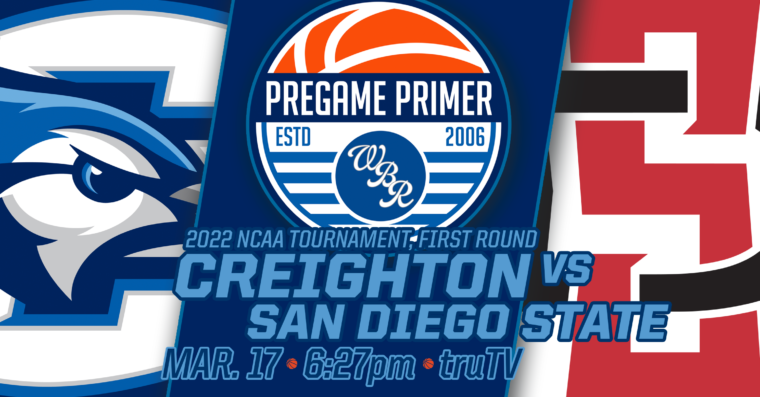Ten years ago this March, eighth-seeded Creighton beat ninth-seeded Alabama 58-57 in the first round of the NCAA Tournament. That 56-possession rock fight, clinched when Josh Jones locked down Alabama’s Trevor Releford on the final possession and forced him to take an off-balance shot at the buzzer, was about as stressful as March Madness gets.
I’ve been thinking a lot about that game this week, because Creighton’s opening matchup of the 2022 NCAA Tournament has a lot of similarities. The Crimson Tide had the sixth-best adjusted defensive efficiency in the country entering that game, but were average offensively; San Diego State comes into Thursday’s matchup ranked second in the country in adjusted defensive efficiency but is below average offensively. Most pundits see this as a low-possession, high-intensity battle decided in the final minute.
San Diego State enters the tournament winners of 11 of their last 14 games, and the three losses came by a combined three points to fellow NCAA Tournament teams — one-point road losses to Colorado State and Boise State by identical 58-57 scores, and a 53-52 loss to Boise State in the Mountain West title game.
At the top of the scouting report is senior Matt Bradley, a graduate transfer from Cal who is their only player to average in double figures at 17.0 points per game. Bradley is lethal from just about anywhere; he’s made 41.4% of his threes (57-of-137), 39.8% on midrange jumpers, and 56.1% on shots at the rim. He has great size for a guard at 6’4” and 220 pounds, making him hard to stop in the paint when he gets a head of steam rolling; who the Jays defend Bradley will be interesting. Do they stick Trey Alexander on him, who is a bit better on-ball defender but gives up 35 pounds to him? Or go with Alex O’Connell, who is taller and longer and a better perimeter defender, but not as good at stopping the dribble?
Whoever draws the assignment will face a guard with a lot of tools in his arsensel:
Bradley struggled in the MWC Tournament last weekend, leaving some to wonder how much is left in the gas tank for a warrior who’s been tasked with such a heavy offensive burden all season. In the first two games, he shot just 4-of-14, scored 12 combined points, and had nine turnovers. Against Boise State in the title game, he had 17 points but needed 17 shots to get there (4-of-13 on twos and 2-of-4 on threes). It’s probable that a senior who is finally in his first NCAA Tournament finds another gear and renders last weekend’s struggles a moot point. It’s also possible he’s worn down and will struggle against a physical defense. It’s absolutely worth watching closely, because he’s by far their biggest offensive threat.
Senior forward Nathan Mensah is the Mountain West Defensive Player of the Year after blocking 2.2 shots per game (and altering or changing numerous others). He averages 7.3 points and a team-leading 7.1 rebounds per contest. Interestingly, his 190 shot attempts have been split nearly even between shots at the rim (91) and midrange jumpers (95) — interesting because he’s really, really good at the former (62.9%) and below average at the latter (35.8%).
Point guard Trey Pulliam averages 8.5 points per game and tops the Aztecs with 103 assists. More a distributor than scorer, Pulliam is a decent shooter inside the arc, primarily on pull-up jumpers. He doesn’t get to or finish at the rim well, and doesn’t shoot the three particularly well, either. But he’s expert at setting up Bradley all over the floor and Mensah in the paint.
Creighton’s defense revolves around their guards running over nearly every screen, funneling the dribble toward Kalkbrenner where he blocks or alters shots better than almost anyone. Combined with their drop coverage, it encourages opponents to take short/medium jumpers rather than challenge them at the rim.
Those are the shots SDSU’s top scorers love to take. 42.1% of Bradley’s total shot attempts have been two-point jumpers. 50.0% of Mensah’s shots have been from there, and 56.1% of Pulliam’s have been two-point jumpers. Assuming they struggle to score at the rim — both because they’ve struggled to do so over the course of the season, and because they’re facing an elite rim protector in this game — whether they knock down midrange jumpers or not could be a deciding factor in the game
But their offense isn’t where they win or lose games. SDSU’s defense gets the headlines, and for good reason. With an adjusted defensive efficiency of 86.1, they are a full six points better than Creighton who had the best mark in the Big East at 92.1.
SDSU’s opponents have played the slowest pace in D1, at 19.2 seconds per possession, for all the reasons you’d suspect — the Aztecs keep opponents from running in the open floor by cleaning up on the offensive glass and limiting turnovers, and then in the half court, their length and athleticism take away your first (and second, and often third) options. Opponents often get impatient, and try to force things by taking ill-advised shots, making risky passes, or dribbling into traffic, which compounds the problem. SDSU’s opponents have had a turnover on 21.7% of their possessions, 29th most in D1, and have had the ball stolen away on 11.4% of possessions, 43rd most.
There aren’t many, if any, holes in their defense. They block 14.4% of opponents shots, a big reason they allow teams to shoot just 43.1% on two-pointers (sixth-best in D1 and well below the D1 average of 49.7%). Because of the difficulty scoring in the paint and at the rim, opponents resort to shooting lots of threes; nearly 40% of opponent’s shot attempts have come from behind the arc (well above the D1 average), where they shoot just 30.4% (33rd worst and also well below the D1 average of 33.7%).
One of the biggest reasons the Aztecs are so efficient defensively on the perimeter is because they have the ability to switch almost every screen without worrying about mismatches. Against most teams, that’s served them well. Against Creighton, switching screens in the paint will allow the Jays to exploit Ryan Kalkbrenner against smaller defenders — and against someone other than SDSU’s great post player, Nathan Mensah. They faced a seven-footer 12 times this season, and in those games, the opposing big man shot 50.5% on two-pointers — remember, opponents have made just 43.1% of their two-pointers overall. Getting touches at the rim for Kalkbrenner early, often, and then doing it again is one of CU’s biggest keys to victory. He had 15 second-half points against Villanova on Saturday; he’s scored 12 or more points in 11 straight games.




